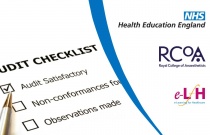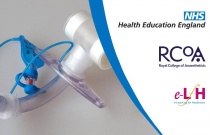CEACCP: Environmental emergencies in theatre and critical care areas: power failure, fire, and explosion CEACCP - Apr 2015
Lachlan F Miles MBBS (Hons) PGCertCU, Carlos D Scheinkestel MBBS FRACP FCICM DipDHM and Glenn O Down
0.50 Hours
Lachlan F Miles, Carlos D Scheinkestel and Glenn O Downey provide us with an overview on Environmental emergencies in theatre and critical care areas: power failure, fire, and explosion
Epidemiology: Basic Principles
Paul Silcocks
0.50 Hours
An overview of basic principles and concepts of clinical epidemiology.
Audit: Basic Principles
Andrew Smith and Matt Baird
0.50 Hours
This session explains what audit is, what it is useful for and describes the steps required to make audit effective.
Common Motor/Movement Problems Part 2: Motor Disorders
Jane Williams and Elizabeth Marder
0.50 Hours
This session concentrates on deviant motor developmental progress.
Recurrent Abdominal Pain in Children
Alison MacIsaac and Malin Sullivan
0.25 Hours
This session considers the management of children who present with recurrent abdominal pain in general practice. The management of acute abdominal pain is discussed in the e-GP session ‘Acute abdominal pain in children.
Contraceptive Choice
Alison Swain
0.50 Hours
This session illustrates the importance of contraceptive choice for all women, lists the currently available choices and demonstrates the management of the contraceptive choice consultation in primary care.
Pituitary Problems in Primary Care (including Hyperprolactinaemia)
Sarah Jarvis
0.50 Hours
The session looks at the pituitary gland and associated disorders. Prolactinomas and associated symptoms are covered, along with the pathophysiology of pituitary insufficiency and its investigation and management.
Quality Improvement for Community and Primary Care Settings
Paresh Dawda
This session aims to introduce the principal methodologies used within healthcare to improve services, specifically methods relating to community and primary care type settings. This sessions supports the development of leadership in clinical settings.
AKI - Fluid Resuscitation
Mark Thomas
This session will explain how to assess volume status in the sick adult patient, including the patient with acute kidney injury, and how to use fluid therapy in adults. Key facts and evidence regarding use of intravenous fluids in acute kidney injury will be covered.
Properties of an Ideal Intravenous Induction Agent
John Peacock
0.50 Hours
This session will provide an understanding of the properties that make up the ideal intravenous induction agent whilst also listing how the currently available agents meet these ideals. Reference will be made to historical agents where they illustrate important facts not covered by current agents.
Reversal of Neuromuscular Blockade
Elizabeth Flockton and Christopher J Parker
0.50 Hours
This session reviews both the assessment of residual neuromuscular block and the mechanism of action of the chemical agents that antagonize it.
Antihypertensive and Hypotensive drugs
Sue Hill and Sarah Mercer
0.50 Hours
This session describes the management of patients with pre-existing hypertension and then examines ways of deliberately reducing blood pressure intraoperatively.
Antiepileptic Drugs (AEDs)
Jane Bembridge MB.ChB(Hons) FRCA
This session will classify antiepileptic drugs (AEDs) according to their mechanism of action and discuss their uses and interactions.
Acid and Bases
Ben Messer and Kaye Cantlay
0.50 Hours
This session defines terms commonly used in acid-base chemistry and relates the importance of acid-base balance to the anaesthetist. Conventional models of acid-base chemistry are examined and the functioning of the glass electrode used for measuring pH is reviewed.
Breathing Systems - Circle System
David Pang
0.50 Hours
The circle system is the most common system used during the maintenance of anaesthesia. This session explores the principles of how the circle system works and also describes the components used within it.
Oropharyngeal and Nasopharyngeal Airways
James Wood
0.50 Hours
This session provides an introduction to airway adjuncts, their uses and contraindications. Maintenance of the airway is of paramount importance in anaesthesia, and indeed the whole of medicine. Airway adjunct devices aid the maintenance of an open airway.
Classification and Function of Ventilators
David Baker
This session will cover the definition and classification of ventilators used in pre-hospital and emergency care, the operating theatre, and intensive care.
Equipment - Humidification
Gordon Flynn
0.50 Hours
Humidification of inspired gases is a vital process by which the body moistens and warms the gases that we breathe. Breathing gases which are not humidified can lead to damage of the cells lining the respiratory tract, impairing ciliary function and increasing the patient's susceptibility to respiratory tract infection. During t....
Arterial Blood Gases
Cyprian Mendonca
0.50 Hours
Measurement of blood gases is vital to assess gas exchange function of the lungs, to titrate oxygen therapy and to assess metabolic state of the patient. A basic understanding of the working principles of the equipment used in measuring blood gases, their limitations and sources of error is essential for interpretation of blood....
Equipment for Peripheral Nerve Block
André van Zundert and Baha Al Shaikh
To perform successful peripheral nerve blocks, it is essential to have sound knowledge of anatomy, in addition to a good understanding of neurophysiology and the basics of nerve stimulation. This session explores the history of electrical nerve stimulation in regional anaesthesia, the design of the nerve stimulators and the need....
Respiratory Tract Infection Part 1
Joy Kean
0.50 Hours
This session will outline the transmission routes and the pathological detail of an influenza virus infection. Virus structure will be discussed and classification based on this structure will be highlighted.
Cellular oxygen utilization in health and sepsis
GI van Boxel PhD BSc BMBCh, WL Doherty BMSc MBChB FRCA FFICM and M Parmar BSc MBBS MRCP FRCA
0.50 Hours
This article describes the fate of molecular oxygen as it passes from the airway through the circulation into the cell.
Anaesthesia and intensive care for major burns
Sophie Bishop MBChB (Euro) FRCA and Simon Maguire MBChB, FRCA
0.50 Hours
Major burns are systemic injuries requiring input from multiple specialities. There are 140.000 cases of new burns per year presenting to emergency departments in England and Wales, with around 10% of these being admitted to hospital. Of these, 4000–5000 cases are complex and require the services of a regional adult burns unit.....
Safe Transportation of Patients with Complex Burns
Samantha Valvis and Fiona Wood
0.50 Hours
This session describes the modes of transportation that are commonly used to transfer patients with complex burns and explores the hazards that may arise during transportation.
























